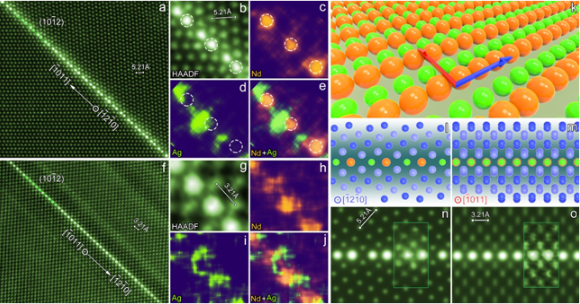The research team led by Professor Nie Jianfeng from the School of Material Science and Engineering, director of Electronic Microscope Center of Chongqing University, published a paper titled “Direct observation and impact of co-segregated atoms in magnesium having multiple alloying elements” in Nature Communications (impact factor 11.88), a sub-journal of Nature, with Chongqing University as the first organization and the corresponding organization. Professor Nie Jianfeng of Chongqing University is the corresponding author, and Zhao Xiaojun, a doctoral candidate, is the first author.
The boundary segregation of solute atoms would play a decisive role in the macro-properties of materials. The research of boundary structure and components of materials has always been one of the hot topics of the material area. The HAADF-STEM technology used in the scanning transmission electron microscope has been the most commonly used method to study the boundary solute atom segregation on the atomic dimension in the past more than ten years. Its image density was in direct proportion to the square of atomic number and could be used to reveal the distribution of solute atoms with bigger atomic numbers at the boundary in the binary material system on the atomic dimension. However, for materials with approximate atomic numbers and materials containing several alloying elements, HAADF-STEM was not enough to identify the types of atoms in a single atomic beam. Generally a combination with X-ray EDS analyzing technology of the atomic dimension was required. The atomic segregation of light alloy was easily damaged by the high-power electron beam and it has therefore been impossible to directly obtain the EDS image of a single atomic beam.
The research team led by Professor Nie Jianfeng developed the distribution technology of atomic-dimension x-ray element planes applicable to magnesium alloy and aluminum alloy based on the aberration-corrected scanning transmission electron microscope of the Electronic Microscope Center. This paper described a new periodical segregation phenomenon of solute atoms (as shown in Fig. 1) on the twin-plane boundary, in which Nd and Ag atoms respectively occupied the tension and pressing positions on the twin-plane boundary of Mg-Nd-Ag alloy. The research team directly identified the distribution of Nd and Ag using the x-ray element plane distribution technology on the atomic dimension. The first-principle calculation indicated that the segregation could effectively pin the twin-plane boundary and result in a new twin-plane boundary migration mechanism.
This project has been supported by the National Natural Science Foundation and the National Key R&D Program.
Link of the paper: https://www.nature.com/articles/s41467-019-10921-7

HAADF-STEM of atomic dimension and EDS image reveal the periodical segregation of Nd and Ag atoms on the twin-plane boundary of magnesium alloy.
